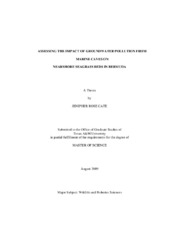| dc.description.abstract | This investigation characterized karstic and nearshore environments of Bermuda
to describe 1) behavior and periodicity of cave springs; 2) submarine spring water
quality; and 3) nearshore marine seagrass density. Caves can be conduits for
groundwater pollution where terrestrial anthropogenic processes leach nutrient enriched
water into marine caves springs that flow directly into coastal waters. Seagrass may
serve as an environmental indicator due to its susceptibility to anthropogenic pollution.
In 2007, environmental water monitoring devices were moored at the entrance of
coastal cave springs throughout Bermuda to retrieve data on water quality, flow
volume, velocity and direction. Nutrients (nitrate, phosphate, nitrite, and ammonium)
and fecal bacteria (Enterococcus spp. and Escherichia coli) were measured in each cave.
To qualify a link between terrestrial pollution and the nearshore environment, seagrass
density within 100 m from cave entrances were measured.
Bermuda caves were tidally influenced. Caves in Harrington Sound showed a
delayed tidal flux with smaller ranges due to the restricted tidal inlet. Four caves
exhibited a 1:1 in:out flow ratio. Caves with an imbalance flow ratio could be influenced
by additional entrances, connection to an alternate water body, or cave geometry. Cave
water was similar between caves. Environmental parameters and nutrients changed
together, excluding seasonal variations in temperature (17.89 to 22.94 degrees C). Higher
nutrients and fecal coliforms within caves indicated sewage may be leaching into the
subsurface ground water system. Three seagrass species were evenly distributed within patchy meadows. Densities
ranged from 0.91 to 4.5 (on a Braun-Blanket Scale). Higher mean densities in
Harrington Sound, suggested the enclosed, protected nature of the sound allowed for
reduced wave and current action. Syringodium filiforme decreased in density towards the
ocean signifying a direct influence of cave water on seagrass beds. Tidal in and out-flux
allowed for a constantly changing environment suitable for a mixture of seagrass
species. Higher dissolved inorganic nutrient concentrations were associated with
locations lacking seagrass.
This study found 1) cave springs connected groundwater and nearshore seagrass
ecosystems; and 2) components associated with terrestrial sewage pollution (DIN,
HPO4=, and Enterococcus spp.) were higher within caves than nearshore waters. | en |


